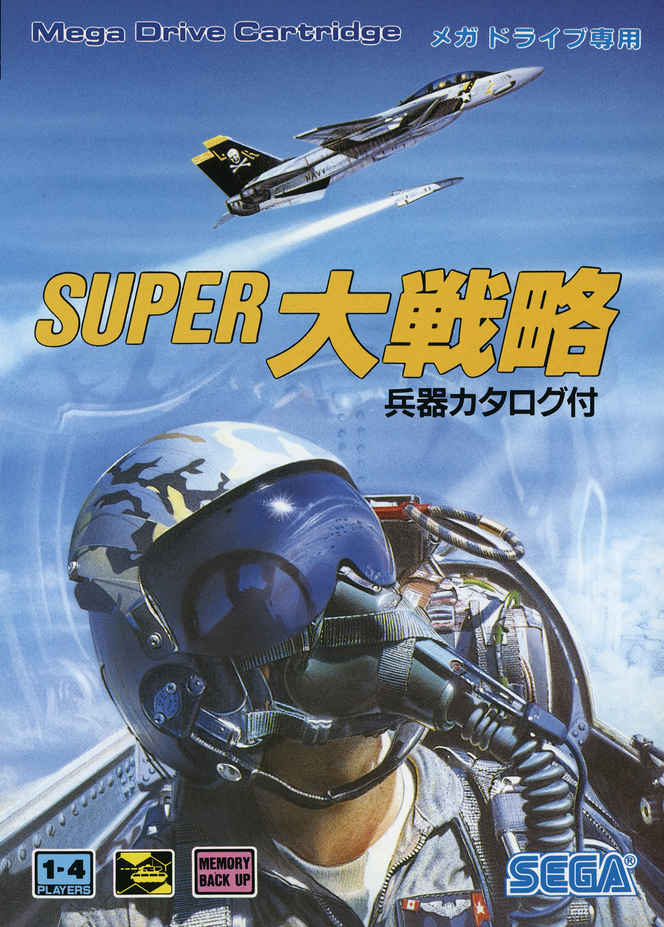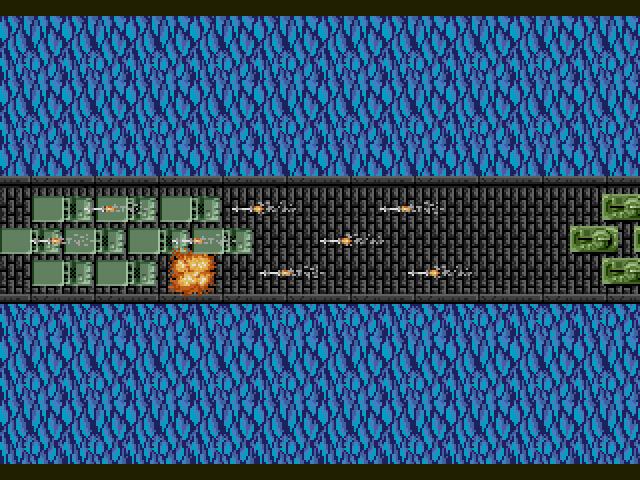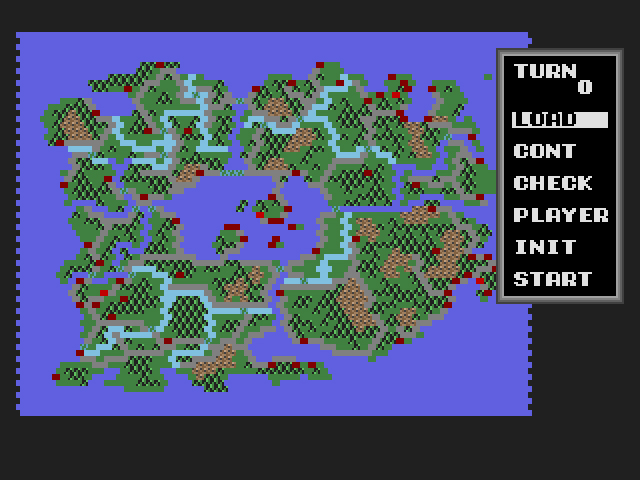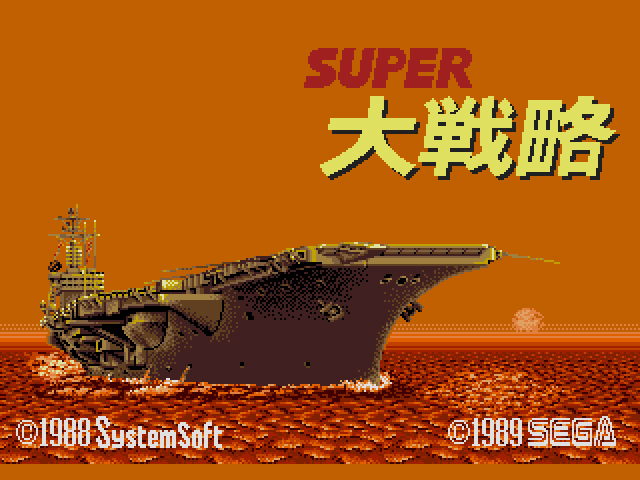
PLAYERS: 1-4 alternating
PUBLISHER: Sega
DEVELOPER: SystemSoft (port by Sega)
GENRE: Strategy
RELEASE DATE: 04/29/89 – (JP)
To quote Hardcore Gaming 101, the Daisenryaku series (translated as ‘Grand Strategy’) is “one of Japan’s oldest strategy game series, featuring hex-tiled, turn-based battles with a ton of real-life military units.” Super Daisenryaku does not deviate from this formula. While the series is predominantly focused on World War II, the maps available in Super Daisenryaku show that developers SystemSoft Alpha aren’t opposed to fantasy. “Neo Tokyo 2101” and “Setonaikai Wars” look to the future, while “Phantasy Star II” and “SEGA LAND” (in all caps, of course) are two of the Sega-themed maps exclusively on the Mega Drive version of the game. Strangely, the map names and the main menu options are in English, while the strategy menu options are in Japanese.

If you’ve ever played a turn-based strategy game, like Romance of the Three Kingdoms or any other early Koei title, you can probably guess your way through most of Super Daisenryaku. You have your standard air and ground-based vehicles and troops, which you can move a certain amount of tiles based on the terrain and the vehicle/troops abilities. Your objective seems to be to protect your base, while laying waste to your opponent’s base and their manpower. When units from opposing sides engage each other, the game shows an automatic battle cinematic that neither side can control. You can supply your troops, look at the map, call for reinforcements. There is certainly more to Super Daisenryaku than this, but this is what I gathered based on my limited kanji knowledge.

The problem with Super Daisenryaku is pacing. Maneuvering your own units around the map doesn’t take very long, but the computer likes to strategize and waste your time. With the amount of time the computer takes for decisions, you’ll think the game has frozen. Thankfully, in the ‘Player’ option on the main menu, you can decide which of the four multi-colored units the computer will control. Switch at least two of the three computer-controlled units off, lest you be playing Daisenryaku all the way to the nursing home.

There’s very little information available for Super Daisenryaku on the English-speaking side of the Internet, and for good reason. Not only did the game never see an English release, the only English patch available was released by Gaijin Productions for the PC Engine CD version. While I applaud their efforts and kind of understand why they went this route – the PCE CD port was released in 1990 and is, if nothing else, a better looking version than the Mega Drive – emulating PCE CD games isn’t the quickest endeavor unless you own an original copy. A Mega Drive patch makes more sense. The Mega Drive is easier to emulate, and the console’s larger following (compared to the PCE CD) would have exposed Super Daisenryaku to a wider audience.

While a fan base surely exists for the Daisenryaku franchise in Japan, its staunch emphasis on slow-paced turn-based strategy and lack of official Western releases means few English speakers care about it and fewer still have heard of it. I dare say we aren’t missing much. While Super Daisenryaku isn’t poorly developed by any means, at its best it plays like a product of an earlier time, and at its worst, it will bore all but the most devoted gaming strategist to tears. Save your kanji skills for a different game.


24 replies on “Super Daisenryaku (Mega Drive, 1989)”
Ugh! For me these games should stop on PC’s along with flight simulators they are niche at best and boringly complex.
Looking ahead seems a mixed bag but there are a number of absolute gems in the 1989 rosta.
Sega !
Yeah, the Mega Drive has some first year jitters, like all new systems. Some good ones in there too, though, like you said.
You vastly overestimate just how hard it is to emulate the PC Engine / PCE CD.
It took me all of 10 minutes to download an ISO and get PC Engine CD games to run in Mednefen. Hell, you don’t even need to track down a system BIOs like you have to do to play Sega CD games in Kega Fusion.
If you would please provide your methods, I’d be much obliged.
http://www.fantasyanime.com/emuhelp/emuhelp_mednafen.htm
Thank you!
Update: getting the PCE-CD version of Super Daisenryaku to run took some time, but I got it. In Japanese only, unfortunately. For whatever reason, the English patch didn’t work, despite claiming otherwise when I attached it to the file. And Mednafen itself is a hot mess of an emulator. I still maintain that a Mega Drive translation would have been a better idea.
So what’s the rating?
No rating. I wasn’t able to play it enough for my liking.
This is a game I would agree should get a translation patch, because this style of game, while niche, is popular enough to garner such a release. As you slogged through the NES library, you would have played all the Koei strategy games, along with a small handful of additional games like Desert Commander for NES, which I particularly enjoyed playing with a friend when we were kids. I didn’t get heavily into this genre, but I see the appeal, and would be interested in playing more of this style form the 16-bit era.
The Koei games are very thorough with what they allow you to do, compared to what I played of Super Daisenryaku. The latter seems to be in-depth battles and that’s it.
Good overview. It’s great to see people discussing this old game, still getting some attention if not love. For myself, I quite enjoy Super Daisenryaku. Like Daisenryaku II Campaign edition which came out a year or two later, Super DS released across multiple systems. I prefer the Sharp X68k version (emulated of course) for the more attractive graphics, superior battle animations & sound effects and a welcome absence of irritating music. The main flaw is no ranged weapons and no Fog of War, the latter seems to be common to all the Super DS variants.
Yes, all the Daisenryaku games from Super DS down to the present are more or less slow paced. Turning off the battle animations can speed things up considerably. I generally enjoy watching them but for the games where they play out too slowly or are flat out ugly, I turn them off. The other thing is, you can just do something else while the AI turns are in progress. You can assess what was done by examining the map and condition of your troops when it’s your turn.
As mentioned, the victory conditions entail wiping out the enemy or capturing his capital. On certain maps a disadvantageous layout can lead to a stalemate where it’s hard to project your power towards a distant enemy capital and conversely, easy for him to heal his units and spawn new ones in proximity to the front. For the most part, all other things being equal, your superior human generalship tilts the balance of city ownership increasingly in your favor, grinding towards the inevitable endgame. The later games with FoW make surprise airborne/helicopter assaults on the enemy capital a viable tactic but here there’s little chance of turning things around once one side gets behind in revenue generation.
And I’d say that interest in military hardware is a prerequisite. Super DS has that late Cold War ambiance, and for me that’s refreshing, a nice change of pace from DS VII (Xbox) or either of the DS Exceeds (PS2/PS3). The variety of playable factions is a plus. The X68 version also has an extra map disc which considerably adds to the replay value. Although your units do level up in experience, so far I haven’t figured out a way to save any to deploy in other scenarios. The Daisenryaku games featuring a campaign are rather more dynamic because the linked scenarios have time limits and there’s the added appeal of building your core army into a deadly fighting force. But Super Daisenryaku is a nice early example of the series and the simple design allows it be played in Japanese without much trouble.
Bless you for posting this in-depth comment! I was really hoping someone would drop by the site and uncover more about this series.
Hi Dylan,
Thanks, I’m glad if it proves of some value. On the Sega Daisenryaku topic, besides the well known “Iron Storm”, there’s a fellow named Mack Draper who has translated a couple of worthy WW2 games into English, complete with manuals.
http://www.knology.net/~mackdraper/
I prefer the older Saturn game “Advanced Military Commander” for the simpler maps but “Advanced Military Commander 2001” which came out on the Dreamcast is a more polished game. Both feature in-depth German campaigns with technological R&D and leveling up of your units. Truly thorough treatments into which players so inclined can sink 100’s of hours. 😉
Cheers,
Steve
Awesome Steve, thanks for the link! Mack Draper’s dedication is intense. And yet, he skipped Super Daisenryaku? 😉
Haha yeah, how could he overlook it ?
At the risk of running this topic into the ground, I should mention the Sega Super Daisenryaku player is not completely without resources:
The Japanese manual here:
https://archive.org/details/Super_Daisenryaku_1989_Sega_SystemSoft_JP
And a very nice unit handbook:
http://www.segaretro.org/File:Superdaisenryaku_md_jp_catalog.pdf
Also in Japanese, but with enough good illustrations to at least indicate what’s what and a comprehensive index of every weapons loadout at the back.
Cheers,
Steve
Strange how the series has an American theme but no western release. Games like this have their place but I think that place is on the PC. Given the “blast processing” nature of the Mega Drive marketing campaign it seems odd to have such a slow game so early in the console’s life.
The fact that the Daisenryaku games have mostly stayed in Japan (save for one or two on the PS2/Xbox) says a lot, I think.
And when the Mega Drive debuted… I know Sega didn’t want to treat it like the Master System and SG-1000, but I don’t think they had figured out what to do with it yet. Sega’s problem has always been a lack of direction. It seems like they’ve never had a good guide at the helm of the company, at least in Japan.
Yup, Daisenryaku is a niche genre, no question. Although Iron Storm was well liked by those who played it on the Saturn, no further WW2 games was forthcoming in English. And as you mentioned, DS VII and Exceed were localized for the Xbox/PS2 respectively. I actually like this as a console game. Although playing on Gens emulator, it’s a lot handier with the gamepad than fooling with the mouse and keyboard.
I’m learning this one now and It’s growing on me. Got the abysmal music turned off now, what a relief. I do like the extras in the Sega version, ranged attack (the artillery battle animation is a hoot) and a naval element. Too bad the maps are an eyesore. It’s amazing how different the X68k and Sega Super Daisenryaku versions are.
Well said about Sega. Even at Sega US, my kid worked there as a game tester some time ago. Fun for us, he used to bring home games in development like Crazy Taxi and Metropolis Street Racer. The latter had a lot of potential which it realized on the Xbox as the Project Gotham Racing series. It all sounded pretty disorganized, then they basically canned all the testers and as I recall they won a small settlement against Sega.
Cheers,
Steve
That’s cool you’re playing this one now, Steve. I just assumed this was how all late 80s strategy games looked, but you’re right, the maps are an eyesore.
Awesome insight into Sega via your son. Sounds like he worked there during the Dreamcast days, so I’m not surprised things were a mess.
Oh man initially , they wanted to advertise the 16-bit graphics and arcade ports. It was all about the arcade man. Maybe the first home system to really give pretty accurate home ports. All the early ads had nice screenshots of how the games looked. And lots of arcade ports. I think Daisenraku didn’t fit the mold so didn’t see a release here. Later though Genesis would see a ton of strategy games. Also Iron Storm as mentioned above is a Daisenraku game and was bought here by working designs and is one of the better games on the platform.
This game was years before the blast processing slogan.
True but the point was still the same – mega drive was faster
ATTENTION!
I prtscrn, OCR’d and translated all menus in the game. I posted it on segaretro.org/Super_Daisenryaku
Hope to get you all playing this marvellous game with me.
I’m 53, played this game in 1989 and rediscovered it through GEN/GS emulator. Get it on playing!!